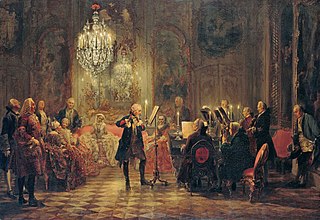
Op. 70 is a set of two Piano Trios by Ludwig van Beethoven, written for piano, violin, and cello. Both trios were composed during Beethoven's stay at Countess Marie von Erdödy's estate, and both are dedicated to her for her hospitality. They were published in 1809.

Chamber music is a form of classical music that is composed for a small group of instruments—traditionally a group that could fit in a palace chamber or a large room. Most broadly, it includes any art music that is performed by a small number of performers, with one performer to a part. However, by convention, it usually does not include solo instrument performances.
A piano trio is a group of piano and two other instruments, usually a violin and a cello, or a piece of music written for such a group. It is one of the most common forms found in classical chamber music. The term can also refer to a group of musicians who regularly play this repertoire together; for a number of well-known piano trios, see below.

The Symphony No. 7 in A major, Op. 92, is a symphony in four movements composed by Ludwig van Beethoven between 1811 and 1812, while improving his health in the Bohemian spa town of Teplitz. The work is dedicated to Count Moritz von Fries.

Ferdinand Ries was a German composer. Ries was a friend, pupil and secretary of Ludwig van Beethoven. He composed eight symphonies, a violin concerto, nine piano concertos, three operas, and numerous other works, including 26 string quartets. In 1838 he published a collection of reminiscences of his teacher Beethoven, co-written with Beethoven's friend, Franz Wegeler. Ries' symphonies, some chamber works—most of them with piano—his violin concerto and his piano concertos have been recorded, exhibiting a style which, given his connection to Beethoven, lies between the Classical and early Romantic styles.

Ludwig van Beethoven's Piano Concerto No. 1 in C major, Op. 15, was written in 1795, then revised in 1800. It was possibly first performed by Beethoven at his first public concert in Vienna on 29 March 1795. It was first published in 1801 in Vienna with dedication to his pupil Princess Anna Louise Barbara Odescalchi, known to her friends as "Babette".

Vojtěch Matyáš Jírovec was a Bohemian composer. He mainly wrote instrumental works, with a great production of string quartets and symphonies; his operas and singspiele numbered more than 30, including Semiramide (1791), Der Augenarzt (1811), and Robert, oder Die Prüfung (1815).

The Kegelstatt Trio, K. 498, is a piano trio for clarinet, viola and piano in E-flat major by Wolfgang Amadeus Mozart.
The Septet in E-flat major for clarinet, horn, bassoon, violin, viola, cello, and double bass, Op. 20, by Ludwig van Beethoven, was sketched out in 1799, completed, and first performed in Vienna in 1800 and published in 1802. The score contains the notation: "Der Kaiserin Maria Theresia gewidmet". It was one of Beethoven’s most popular works during his lifetime, much to the composer's dismay. Several years later, Beethoven even wished the score to have been destroyed, saying: "That damn work! I wish it were burned!"

Hans Gál OBE was an Austrian composer, pedagogue, musicologist, and author, who emigrated to the United Kingdom in 1938.

Anton Franz Josef Eberl was an Austrian composer, teacher and pianist of the Classical period. He was a student of Salieri and Mozart. He was also seen as an early friend and rival of Beethoven.
A clarinet–cello–piano trio is a clarinet trio made up of one clarinet, one cello, and one piano, or the name of a piece written for such a group.
The Alma Trio was a classical piano trio established in 1942 at the Alma Estate of Yehudi Menuhin in Los Gatos, California.

Peter Schmidl is an Austrian clarinetist.
The Kalichstein–Laredo–Robinson Trio is an American piano trio consisting of violinist Jaime Laredo, cellist Sharon Robinson, and pianist Joseph Kalichstein. The trio is one of the longest-lasting chamber ensembles with all of its original members, having debuted in 1977 at the inauguration of president Jimmy Carter. In 2001 it was named by Musical America as Ensemble of the Year, and in 2011 it was awarded the Samuel Sanders Collaborative Artists Award from The Classical Recording Foundation. In the 2003-2004 season, The John F. Kennedy Center for the Performing Arts appointed Kalichstein–Laredo–Robinson Ensemble in Residence. The trio is widely regarded as perhaps the most seminal piano trio performing today, and are noted for the high quality of their interpretations of the trio repertoire.
The Variations in E-flat major piano trio, Op. 44, by Ludwig van Beethoven, is a series of fourteen variations on a theme, written for piano, violin and cello. Although this may be one of Beethoven's early works it was assigned its opus number when it was published by Hoffmeister in Leipzig, more than a decade after Beethoven began writing it.
A clarinet trio is a chamber ensemble that consists of a clarinet, a bowed string instrument and a piano, or a musical work for such an ensemble. The string instrument can be a cello, a viola, or a violin. Therefore, a clarinet trio can be referred to below:
The String Trio in E-flat major, Op. 3 is a composition by Ludwig van Beethoven, his first for string trio.
The Trio for Piano, Clarinet and Cello in B-flat major, Op. 28, was composed by Ferdinand Ries in either Bonn in 1809 or Aachen in 1810 during the period he left Vienna to avoid being drafted into the Austrian army. It was published in 1811 by Simrock with a dedication to a Mademoiselle Clairette Ludwigs.









